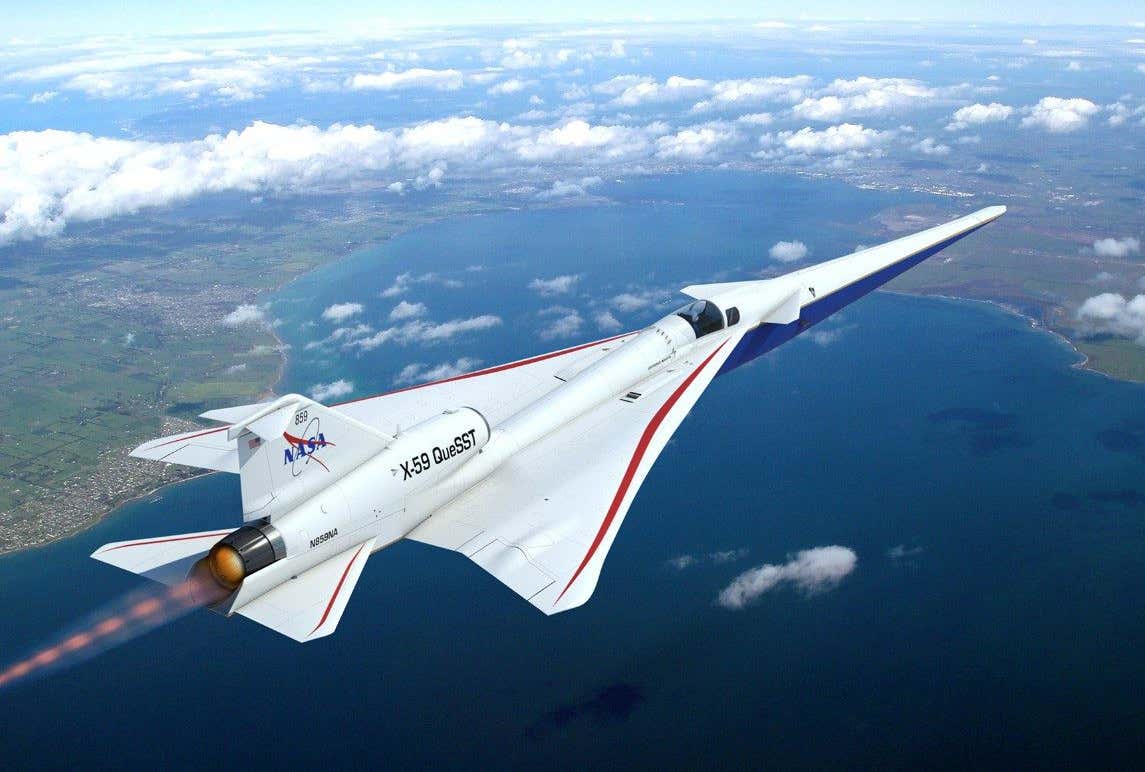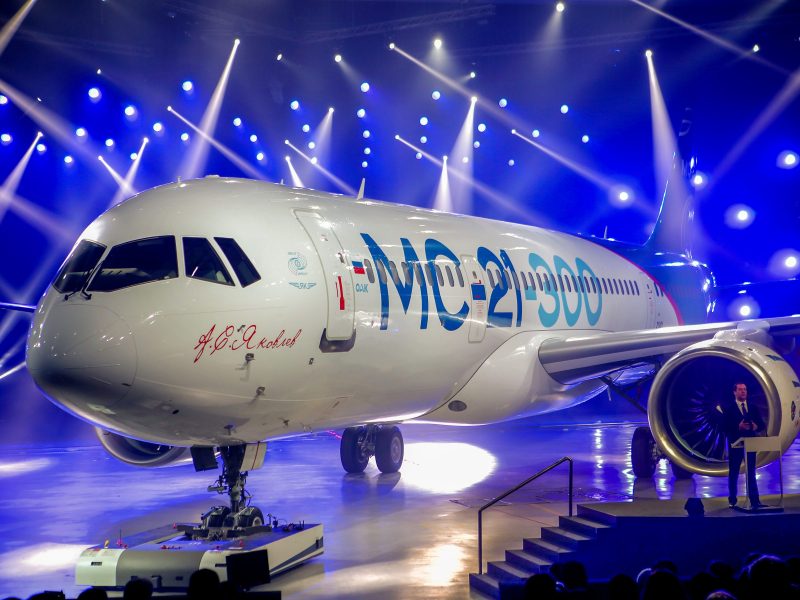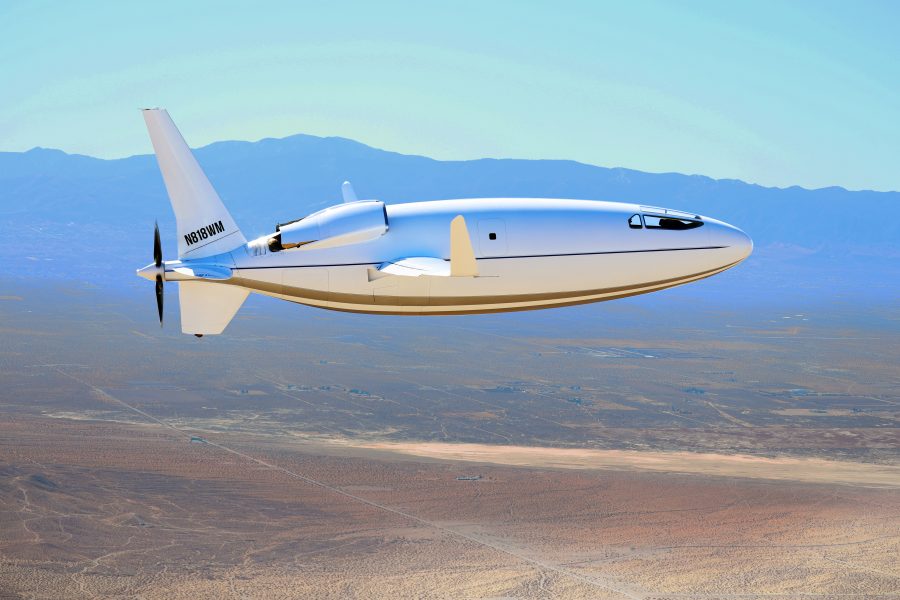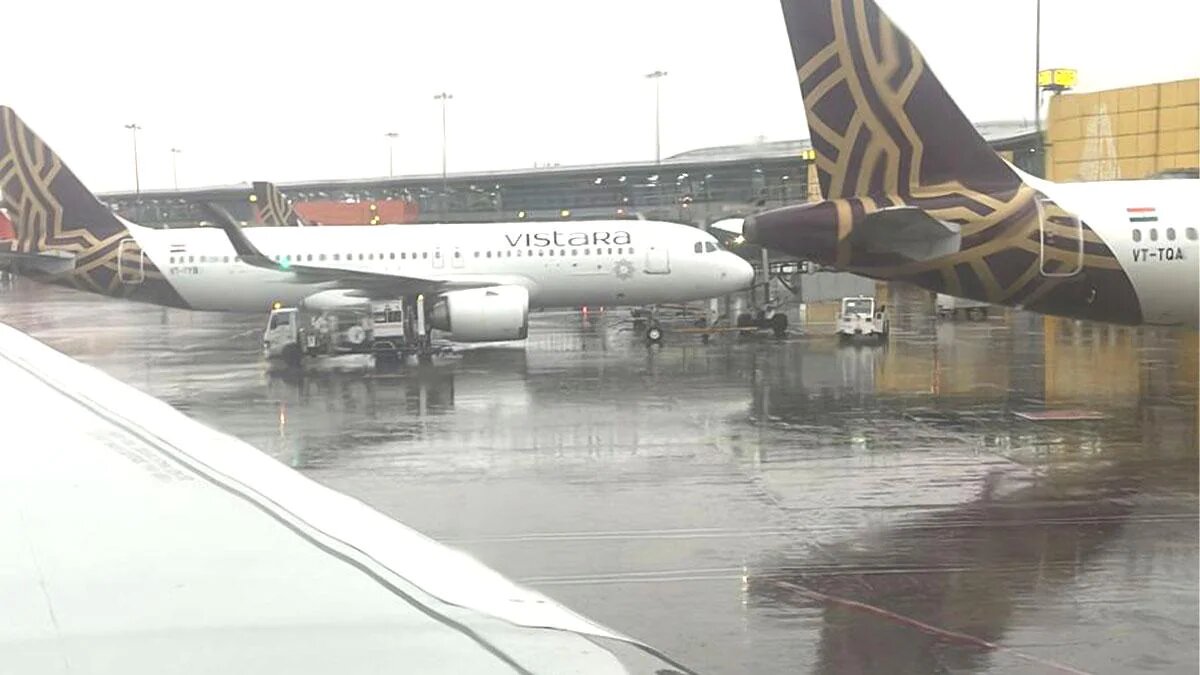Heralding a new era for supersonic flight technology - NASA's "silent" X-59 seen ferried to Lockheed Martin's plant in Texas
Prashant-prabhakar
26 Dec 2021

The Lockheed Martin X-59 QueSST ("Quiet SuperSonic Technology") is an American experimental supersonic aircraft being developed at Skunk Works for NASA's Low-Boom Flight Demonstrator program.
Ahead of a planned first flight next year, the supersonic flight was seen heading to the company's plant in Fort Worth, Texas in a trailer.
The Drive
Design
The new single-seat plane X-59 will be 99.7 feet long, 29.5 feet wide (30 m by 9 m), and will cruise at an altitude of 55,000 feet (16.7 km) while moving at a speed of Mach 1.4, or 925 mph (1,488 km/h). The flush cockpit means that the long and pointed nose-cone will obstruct all forward vision. Instead, it will rely on a NASA-developed eXternal Vision System (XVS) while the Collins EVS-3600 multispectral imaging system, beneath the nose, will be used for landing. United Technologies subsidiary Collins Aerospace was selected to supply its Pro Line Fusion Cockpit avionics, displaying the boom on the ground, and EVS with long-wave infrared sensors.
It will be powered by a single modified General Electric F414, variants of which are featured on Boeing's F/A-18E/F Super Hornet fighters and EA-18G Growler electronic warfare jets, as well as the Saab Gripen fighter jet.
General Electric F414 for X-59 | NASA
Landing gear from an Air Force F-16 fighter, a cockpit canopy from a NASA T-38 trainer, a propulsion system part from a U-2 spy plane and a control stick from an F117 stealth fighter are among the repurposed parts to be used on NASA’s newest airplaneNASA
Unsettling noises, vibrations and the sonic boom have always been inseparable features of commercial supersonic travel. Hence, efforts have always been to silence these booms, which could also be favourable during combat operations.
The X-59 features a nose that is 30 feet long. enabling it to lower the sound of the sonic boom as the jet surpasses the speed of sound at 767 mph (1,235 km/h). Additionally, long, narrow airframes and canards keep the shock waves from coalescing.
CNET
After checkout and envelope expansion flights, the aircraft will be handed over to NASA by Lockheed Martin. The X-59 is touted to fly over select US cities starting 2024 although its first official flight is expected anytime next year.
https://youtu.be/LcvYjkCBY28
SOURCE(s)
COVER: The Drive
Read next
This Russian gamechanger to challenge Airbus-Boeing duopoly in the narrow-body market?
Prashant-prabhakar
25 Dec 2021

In what could be Russia's answer to the popular A320 series and the B737 series by Airbus and Boeing respectively, Irkut MC-21 is all set to enter the narrow-body market and is touted to be the most significant Russian commercial aircraft made in decades. Reportedly, it could also replace the outgoing Tu-134, Tu-154, Tu-204 and Yak-42
Aviacionline.com
A brief history
The Irkut MC-21 program was launched in 2007 by Irkut- a branch of the United Aircraft Corporation (UAC) based in Russia. The standard MC-21-300, powered by Pratt and Whitney PW1000G or Aviadvigatel PD-14 turbofans, has a capacity of 132–163 passengers in a two-class configuration and 165–211 in a single class, and a range up to 6,000–6,400 km (3,200–3,500 nmi).
Assembly of the prototype in January 2016 | Wikipedia
On 8 June 2016, the -300 was rolled out in Irkutsk, East Siberia-six years after the program launch and with 175 orders.
By May 2017, it was almost through all the major ground tests, and after having completed taxi and runway roll tests, the Russian certification was targeted for 2018 and the European Aviation Safety Agency certificate for 2019.
In January 2020, Irkut had received the first PD-14 engines for installation and subsequently, the PD-14-powered MC-21-310 made its maiden flight on 15 December from Irkutsk.
Tech and specs
VariantMC-21-300Cockpit Crew2Cargo capacity49 m3 (1,700 cu ft)Wingspan35.9 m (118 ft)Length42.2 m (138 ft)Maximum Take-Off Weight79,250 kg (174,720 lb)Maximum Payload22,600 kg (49,800 lb)Fuel Capacity20,400 kg (45,000 lb)TurbofansPratt and Whitney PW1000G and Aviadvigatel PD-14Maximum Thrust PW1431G: 31,000 lbs 2-class range6,000 km Wikipedia
The US government-imposed sanctions on some Russian aerospace firms in 2018 brought about a temporary halt in acquiring composite materials for the aircraft airframe, which forced the Russian specialists to develop their knowledge in the same.
It’s positive that the sanctions forced us to develop our own knowledge in composites Irkut sales and marketing director Kirill Budaev
Apparently, the wide fuselage of MC-21 would enable passengers to pass a catering trolley mid-aisle – and its cabin altitude of 1,830m (6,000ft), large windows and overhead luggage bins stand out as striking features.
A 2011 Cabin Mock-Up
Furthermore, the aircraft also features active sidesticks in the cockpit, which would enable each pilot to feel the inputs of the other pilot on the control.
Flight Deck Mock-Up with HUD
The road to competing with its global rivals is a long and tough one and the company has no qualms admitting it.
We’ll seesays Budaev when asked about the possible competition between aircraft of comparable role, configuration and era
Did you know? Although marketed in the West as the MC-21, in Russian it translates to "????????????? ??????? 21 ????" meaning "mainline aircraft of the 21st century".
SOURCE(s)
COVER: Airwaysmag
Read next
After the "flying engine debris" incident, FAA proposes modifications on B777
Prashant-prabhakar
24 Dec 2021

The US aviation regulator FAA, has put forward a set of modifications and safety inspections on certain models of B777. This is in response to recent incidents involving the aircraft type wherein engine debris flew loose from an uncontained engine failure, thereby endangering passengers as happened on a United Airlines 777 bursting into flames shortly after take-off in February, scattering debris over a Denver suburb.
Detroit News
The aforementioned incident led to the grounding of scores of 777s equipped with Pratt & Whitney engines worldwide. Therefore the FAA had ordered checks on all similar engines before any of those models took to the skies again.
Engine debris on the ground | Bloomberg
In a pair of proposed directives released by the FAA in the Federal Register, the aviation regulator has proposed the strengthening of the engine inlets and the addition of shielding on Pratt and Whitney's engines featured on 777-200 and 777-300 aircraft.
On Wednesday, it said these 777 models needed modifications for safety.
The FAA has determined that further action is necessary to address the airplane-level implications and unsafe condition resulting from in-flight engine fan blade failuresthe regulator said in a statement Wednesday, citing three incidents including the one over Denver
Reportedly, the proposals wouldn't be published until the 28th of December and will be open for discussion until the end of January 2022.
We support these guidelines, which reflect our work with the FAA to improve the design" of the engines in questiona Boeing spokesperson told AFP
In the US. only United operates the B777 fitted with Pratt and Whitney engines while most B777s have engines that aren't subject to FAA proposals.
Fox Business
Pratt and Whitney is co-ordinating all actions with the FAA, Boeing and airline operators to ensure the continued airworthiness of the fleetPratt and Whitney
COVER: Wired UK
Read next
Otto Celera 500L - next game-changer in private and commercial aviation
Prashant-prabhakar
24 Dec 2021

With the world becoming more climate-conscious, now more than ever, efforts are on to produce more sustainable products, especially in aviation, which is massively intense when it comes to energy.
Aviation is touted to contribute to about 3% of global emissions which is almost more than twice the entire emission of Netherlands! It is also reported that one international flight produces more emissions than a family car does in a whole year, and that’s after all the emissions after each person is cut out.
With something as inevitable as air travel, how can we, then offset, or at least reduce, all the carbon footprints released during travel?
Otto Aviation's recent unveiling of the "Otto Celera 500L" just might be the answer to that.
Otto Celera 500L | Otto Aviation
The Otto Celera 500L is a business and utility light aircraft developed by American start-up, Otto Aviation. Reportedly, 31 test flights have been flown using the aircraft as of August 2021.
A brief history
Having commenced in 2015, the prototype made its maiden flight in January 2018. After multiple performance tests, the company officially announced the aircraft and its development program in August 2020.
Tech and Specs
Capacity6 passengersCabin Height6 ft 2 in (1.88 m)Cabin Volume448 cu ft (12.7 m3)Powerplant1 × RED A03 diesel piston engine, 550 hp (410 kW) approximate at take-offCruise Speed 400 kn (460 mph, 740 km/h) Range4,500 nmi (5,200 mi, 8,300 km)Service Ceiling30,000 ftMaximum Glide Ratio22:1Fuel Economy13.1–9.4 L/100 kmWikipedia
Competing with light business aircraft like the Cessna Citation CJ3+ jet or the Beechcraft King Air 350, the 500L is a mid-wing monoplane powered by a single RED A03 turbocharged V12 four-stroke aircraft diesel engine of 500 hp (370 kW). Yes, you heard that right- a single-engine!Fret not, as fortunately, the RED AO3 engine is actually two engines in one, with two banks of six cylinders that can operate independently.
RED A03 Engine | Asian Aviation
The 500L comes in an unusual teardrop form, a far cry from the conventional cylindrical shape of most commercial aircraft.
Otto Celera 500L light Interior View | Otto Aviation
Ironically, the fairly stout and blunt nose and a pointy tail only add to the overall aerodynamic efficiency of the plane.
The RED A03 is powered using conventional Jet-A fuel, but features a turbocharged 12-cylinder piston engine, making it operation-efficient.
The aircraft’s efficiency, combined with the engine’s efficiency, makes it not only fuel-efficient but has a range of up to 4500 nautical miles. Imagine flying that long on nothing but raw piston engines!
How does this change the way we fly when it comes to energy efficiency?
Boldmethod
Operating costs with 500L are touted to be only $328, which is miniscule when compared to flying a business jet (over $2000 hourly)Carbon footprint per passenger comes to around 150 MPG - roughly three times better than flying commercialEnhanced flying experience with increased headroom, large first-class seating, and much more room in generalCan be modified for military applications too
Innovation at its core is solving a problem without conventional biasWilliam Otto, founder and CEO of Otto Aviation
William Otto | Otto Aviation
Furthermore, the company has designed the model in such a way to include electrical propulsion, later on, further strengthening its place as the next game-changer in sustainable aviation.
FAA certifications are targeted for 2023–2025.
Did you know? The Celera 500L can be scaled up 20% while maintaining its extensive laminar flow. This increase results in a cabin volume nearly double the size of the current configuration leading to a possible 1000L prototype shortly.
SOURCE(s)
COVER: Otto Aviation
Read next
Flight operations at Delhi's Indira Gandhi International (IGI) Airport were affected on Monday, May 23 morning as several parts of the national capital and the NCR received heavy rain with thunderstorms.
The airport authorities have requested the passengers to contact the airline concerned for updated flight information.
Heavy rain disrupts flight operations at Delhi Airport
At least 19 flights have been diverted to Jaipur, Lucknow, Indore, Amritsar, and Mumbai, news agency ANI tweeted quoting Delhi airport sources.
"Due to bad weather, flight operations at Delhi airport are affected. Passengers are requested to get in touch with the airline concerned for updated flight information," Delhi Airport tweeted.
https://twitter.com/DelhiAirport/status/1528540769312722944
All departures and arrivals and their consequential flights have been affected due to inclement weather. Airlines have also requested passengers to check on their flight status before heading to the airport as the flight operations have been kept on hold.
Hundreds of passengers have been stranded since early morning as flights departing from the airport are being rescheduled. The number of affected flights was likely to rise throughout the day as the thunderstorms continue.
https://twitter.com/flyspicejet/status/1528532569629007872
SpiceJet tweeted that the bad weather in Delhi may affect departures and arrivals at the airport and requested its passengers to keep a check on their flight status.
IndiGo also issued a travel advisory for its passengers, asking them to keep enough travel time in hand while travelling to the airport.
https://twitter.com/IndiGo6E/status/1528559043308322817
Meanwhile, India Meteorological Department (IMD) predicted that thundershower with moderate intensity rain and gusty winds with a speed of 60-90 Km/h would continue to occur over and adjoining areas of the entire Delhi and NCR during the next two hours.
Strong winds and heavy rain uprooted trees in parts of Delhi which resulted in roads getting blocked.
IMD said that impact on vulnerable structures, kutcha houses, traffic and visibility is expected and suggested people stay indoors and avoid travel if possible.
Read next
Neetan Chopra appointed as IndiGo's Chief Digital and Information Officer
Radhika Bansal
24 Dec 2021
Budget carrier IndiGo on Thursday, December 23 announced the appointment of Emirates former executive Neetan Chopra as its chief digital and information officer (CDIO), effective January 3.
In this newly-created position, Chopra, who is currently the group chief technology officer at Dubai Holding, will be responsible for all aspects of IndiGo's information technology and systems, processes, and organisation, with a strong focus on attracting, retaining, and developing key IT and digital talents, the airline said in a late-evening statement.
Neetan Chopra
He previously held the position of senior vice-president of IT and innovation at Emirates, according to the statement. According to IndiGo, the newly created role of CDIO will provide vision and leadership for developing and implementing IT and digitalisation initiatives as an integral part of IndiGo's business strategy.
"With IT, technology and digital becoming more and more strategic to the company, and the fact that there will be an enormous focus in terms of innovation and driving digitalisation, we decided to combine the two organisations under a common leadership of a 'chief digital and information officer'.We are pleased that Chopra has chosen to come on board with us. His extensive airline experience in technology and digital disruption will be immensely helpful as we chart IndiGo's future."Ronojoy Dutta, Whole-Time Director and Chief Executive Officer, IndiGo
Having begun his career at Accenture Consulting in India in early 1992, Chopra moved to the UAE and joined Emirates in 1995 as a senior IT manager and served the Gulf carrier till 2018 when he moved to Dubai Holding as their Group CTO, according to the statement.
"We live in unprecedented times and for those who are curious, open and driven, the digital era presents a spectacular array of opportunities. I look forward to co-creating the digital future of IndiGo with our passionate employees, our discerning customers, our collaborative partners, and the world's most vibrant tech ecosystem."Neetan Chopra, Chief Digital and Information Officer (CDIO), IndiGo



Comment